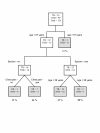Predicting smear negative pulmonary tuberculosis with classification trees and logistic regression: a cross-sectional study
- PMID: 16504086
- PMCID: PMC1402281
- DOI: 10.1186/1471-2458-6-43
Predicting smear negative pulmonary tuberculosis with classification trees and logistic regression: a cross-sectional study
Abstract
Background: Smear negative pulmonary tuberculosis (SNPT) accounts for 30% of pulmonary tuberculosis cases reported yearly in Brazil. This study aimed to develop a prediction model for SNPT for outpatients in areas with scarce resources.
Methods: The study enrolled 551 patients with clinical-radiological suspicion of SNPT, in Rio de Janeiro, Brazil. The original data was divided into two equivalent samples for generation and validation of the prediction models. Symptoms, physical signs and chest X-rays were used for constructing logistic regression and classification and regression tree models. From the logistic regression, we generated a clinical and radiological prediction score. The area under the receiver operator characteristic curve, sensitivity, and specificity were used to evaluate the model's performance in both generation and validation samples.
Results: It was possible to generate predictive models for SNPT with sensitivity ranging from 64% to 71% and specificity ranging from 58% to 76%.
Conclusion: The results suggest that those models might be useful as screening tools for estimating the risk of SNPT, optimizing the utilization of more expensive tests, and avoiding costs of unnecessary anti-tuberculosis treatment. Those models might be cost-effective tools in a health care network with hierarchical distribution of scarce resources.
Figures
Similar articles
-
Clinical and radiographic predictors in diagnosing sputum smear-negative pulmonary tuberculosis in HIV-negative patients: a cross-sectional study in China.Chin Med J (Engl). 2013;126(19):3662-7. Chin Med J (Engl). 2013. PMID: 24112160
-
Algorithm for the diagnosis of smear-negative pulmonary tuberculosis in high-incidence resource-constrained settings.Trop Med Int Health. 2013 Oct;18(10):1222-30. doi: 10.1111/tmi.12172. Epub 2013 Aug 18. Trop Med Int Health. 2013. PMID: 23952335
-
Diagnosis of smear-negative pulmonary tuberculosis based on clinical signs in the Republic of Congo.BMC Res Notes. 2015 Dec 18;8:804. doi: 10.1186/s13104-015-1774-8. BMC Res Notes. 2015. PMID: 26683052 Free PMC article.
-
A novel multi-parameter scoring system for distinguishing sarcoidosis from sputum negative tuberculosis.Sarcoidosis Vasc Diffuse Lung Dis. 2012 Mar;29(1):11-8. Sarcoidosis Vasc Diffuse Lung Dis. 2012. PMID: 23311118
-
Development of a clinical scoring system for the diagnosis of smear-negative pulmonary tuberculosis.Braz J Infect Dis. 2008 Apr;12(2):128-32. doi: 10.1590/s1413-86702008000200006. Braz J Infect Dis. 2008. PMID: 18641849
Cited by
-
Role of flexible bronchoscopy in patients with sputum-negative pulmonary tuberculosis.Indian J Thorac Cardiovasc Surg. 2018 Jul;34(3):365-369. doi: 10.1007/s12055-018-0645-z. Epub 2018 Feb 12. Indian J Thorac Cardiovasc Surg. 2018. PMID: 33060894 Free PMC article.
-
Predictors contributing to the estimation of pulmonary tuberculosis among adults in a resource-limited setting: A systematic review of diagnostic predictions.SAGE Open Med. 2024 May 16;12:20503121241243238. doi: 10.1177/20503121241243238. eCollection 2024. SAGE Open Med. 2024. PMID: 38764538 Free PMC article. Review.
-
Prediction of Multidrug-Resistant Tuberculosis Using Machine Learning Algorithms in SWAT, Pakistan.J Healthc Eng. 2021 Aug 31;2021:2567080. doi: 10.1155/2021/2567080. eCollection 2021. J Healthc Eng. 2021. Retraction in: J Healthc Eng. 2023 Sep 20;2023:9892081. doi: 10.1155/2023/9892081. PMID: 34512933 Free PMC article. Retracted.
-
Rapid detection of Mycobacterium tuberculosis in children using blood and urine specimens.Rev Soc Bras Med Trop. 2020 Sep 25;53:e20200051. doi: 10.1590/0037-8682-0051-2020. eCollection 2020. Rev Soc Bras Med Trop. 2020. PMID: 32997049 Free PMC article.
-
Cost-effectiveness of a tuberculosis active case finding program targeting household and neighborhood contacts in Cambodia.Am J Trop Med Hyg. 2014 May;90(5):866-872. doi: 10.4269/ajtmh.13-0419. Epub 2014 Mar 10. Am J Trop Med Hyg. 2014. PMID: 24615134 Free PMC article. Clinical Trial.
References
-
- World Health Organization Global tuberculosis control: surveillance, planning, financing WHO Report 2000 Geneva. 2000.
-
- Colebunders R, Bastian I. A review of diagnosis and treatment of smear-negative pulmonary tuberculosis. Int J Tuberc Lung Dis. 2000;4:97–107. - PubMed
Publication types
MeSH terms
LinkOut - more resources
Full Text Sources



